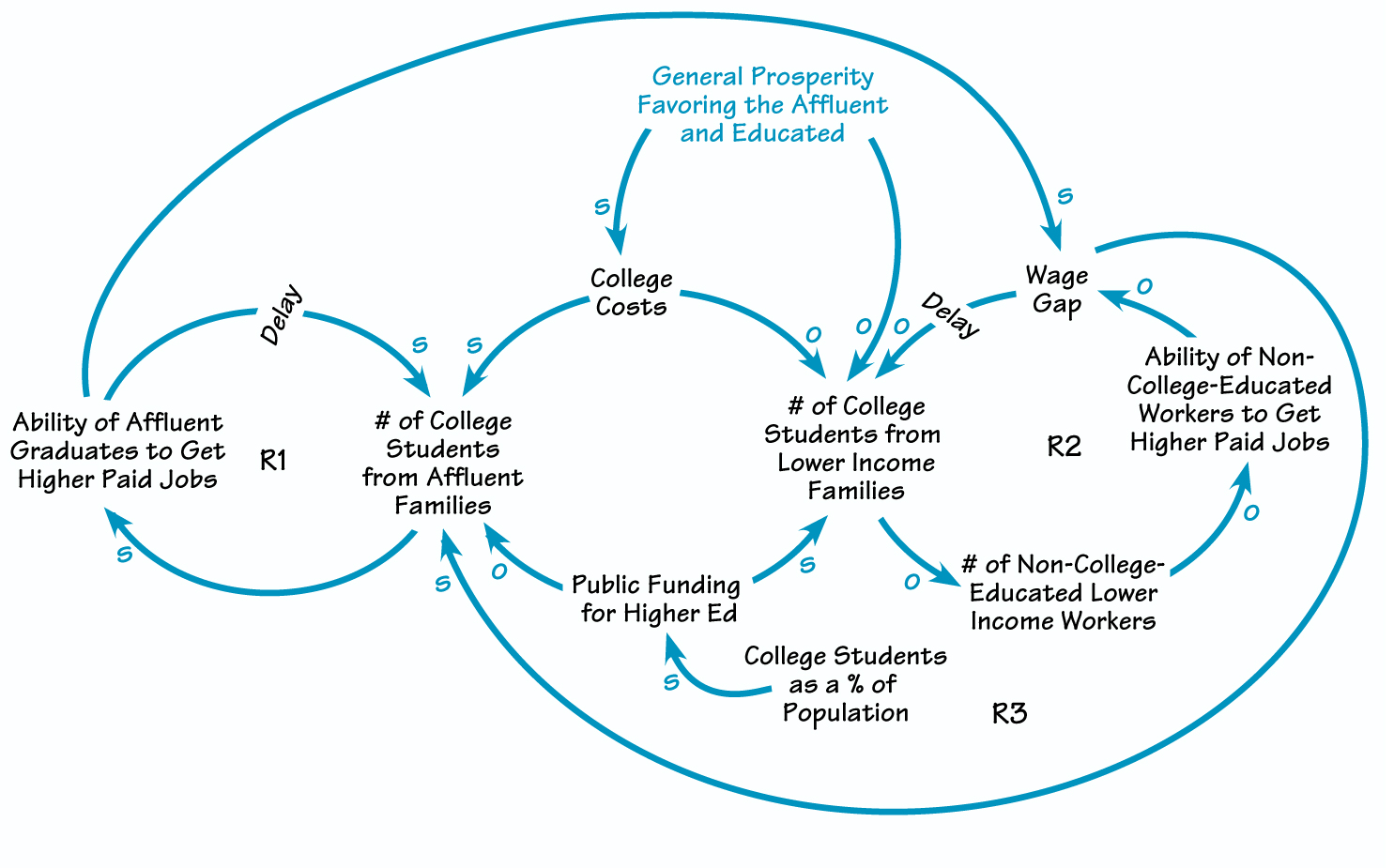In the December/January issue, we considered the question of whether increased funding of higher education might help to close the income gap in the United States. Prinny Anderson, a principal at Design for Learning, sent in a causal loop analysis of the dynamics in this situation. Her comments focus on a systems archetype that may be at work in the scenario. Bill Braun, who teaches systems management and organization theory at Baldwin Wallace College, invited a team of students—Angela Fleming, Tracy Garcia, Victoria Pate, and Joe Perdue—to create stock and flow models of key dynamics in the scenario. Their analysis sheds light on the thinking process a team can experience in tackling a systems thinking project. We’ve printed excerpts from all these readers’ responses here
The Rich Get Richer
I was struck by how self-interest and short-term thinking in this scenario can lead us to overlook larger social needs and longer term consequences of today’s decisions. In fact, my reaction sank into cynicism as I read the final few paragraphs, which propose “a powerful way to close the gap.” The questions that came to my mind were: In whose immediate interest is it to close the wage gap? And are those the same people or institutions with sufficient political power to influence public policy?
There are many dynamics at work in the story. I diagrammed one of them as variations on the systems archetype “Success to the Successful.” The idea behind the diagram is to generate discussion about this structure, its implications, and, for the politically active, leverage points for change.
The Rich Get Richer

This “Success to the Successful” archetype is about how the initial success of highly paid and skilled college graduates from more affluent families favors that group and works against college-age people from lower income families. Two factors drive the dynamic: the decrease in college-age people as a percent of overall population, and the increase in prosperity favoring the affluent. Public funding for education, which appears to be based on demographics, has declined, and increasing prosperity may have contributed to the higher price tag for a college education. As a result of these two dynamics, a growing number of college students come from more affluent families. Individuals from this pool get higher paid jobs, and eventually, they are in a position to send their children to college, too (R1). Furthermore, the prosperity of the affluent, college-educated group comes at the expense of the lower income, non-college-educated group, as the wage gap between them grows (R3).
The same dynamics of reduced funding and rising college costs have decreased the number of college students from lower income families (R2). This means that more children from those families join the pool of non-college-educated, lower income workers. Their ability to get higher paid jobs declines, and the wage gap widens further. Over time, the ability of those families to send their children to college remains low.
With no intervention, this structure will persist and accelerate, at least until some limit is reached. Unfortunately, the means for avoiding the limit take time and money to implement, as the article described.
A Team Tackles the Challenge
(For sample stock and flow models created by the class, go to www.pegasuscom.com/V11N3workout.)
Our Workout progressed along the following four steps.
1. Parsing the Workout and Identifying Salient Variables. First we established a sound understanding of the Workout as written. We listed salient facts and dynamic influences from the narrative, and began to identify simple causal influences and linkages.

2. Building a Baseline Model. The baseline model served two purposes. First, we used it to articulate the Workout’s core hypothesis—that the economic principle of supply and demand could be used as leverage for closing the gap between the earning power of a high-school education and that of a college education. Second, we used the baseline model to stimulate discussion and identify challenges.
3. Challenging the Workout’s Assumptions. We asked ourselves, “Do we concur that an increase in national spending on higher education is both necessary and sufficient to achieve the stated objective of closing the income gap?” We concluded that it was indeed necessary. However, we also found it to be insufficient; that is, it’s a contributing but not a determining influence.
4. Generating Hypotheses and Insights from Group Modeling. We arrived at the following hypotheses and insights.
Boundaries, Assumptions, and Limitations. Defining the boundaries of the model proved challenging. We chose to ignore numerous related but tangential variables, such as economic cycles, intelligence, and the current capacity of colleges. We also kept our inquiry at the societal level, avoiding anecdotes of people who achieved great success against all odds.
 Hypotheses. We propose that motivation and quality of pre-college education play a role in college admission patterns. We identified several leverage points where motivation could be influenced. They all had attributes in common—the frequency, quality, and intensity of guidance given to young people. Opportunities for contact included increased counseling in schools; community resources to support families and provide constructive activities; and encouragement of life-long learning. We also discussed the benefits of making personal mastery a standard component of the curriculum.
Hypotheses. We propose that motivation and quality of pre-college education play a role in college admission patterns. We identified several leverage points where motivation could be influenced. They all had attributes in common—the frequency, quality, and intensity of guidance given to young people. Opportunities for contact included increased counseling in schools; community resources to support families and provide constructive activities; and encouragement of life-long learning. We also discussed the benefits of making personal mastery a standard component of the curriculum.
As for quality of pre-college education, we noted that the approaching increase in the number of college-age people will be found primarily in poor, minority, and immigrant households. These youths will thus likely attend middle and high schools that have comparatively inferior resources. An analysis of how to improve these resources is beyond the scope of this Workout. Nevertheless, such improvement is essential to increasing matriculation rates and enhancing students’ motivation. Family dynamics also come into play—also beyond the scope of this Workout.
Insights. As we dug deeper into the model’s dynamics, we generated numerous insights. As just one example, we frequently encountered limits to growth. Specifically, a number of dynamics could neutralize upward pressure on wages for low-skill jobs. One, as low-skill job wages rise, the incentive to move those jobs offshore increases. If this move occurs, increased unemployment would swell the low-skill labor pool, neutralizing the supply-and-demand leverage on low skill job wages. Two, improving low-skill job wages invites immigration. If the presumed transfer of people from the low-skill labor pool to the high-skill labor pool occurs, the decrease in the low-skill labor pool would be offset by immigrants, who would increase the labor-pool supply and likely work for less money. Three, as low-skill job wages rise and the income gap narrows, the incentive to attend college may decay, eventually stagnating the closure of the income gap.
We also had to keep reminding ourselves to keep an eye on the system as a whole. A number of times, we found ourselves using “exception-to-the-rule” anecdotes in trying to disprove the influence of a particular variable. This was a useful exercise in monitoring our own mental models and reminding ourselves to suspend judgment. Everyone acknowledged that learning took place, and that we discovered points of view we had not previously considered. The Workout showed us where expanding one’s field of vision can lead. In the end, we had no hard answers, many good insights, and one nagging question—where is “the” leverage point? It may well lie in the deep beliefs we have about social class and society. We sense that a paradigm shift in the way we think is necessary—though perhaps still not sufficient—to close the income gap.
